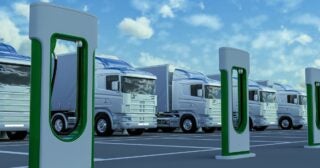- Resources
- Why 2023 is the year for companies to join the electric truck transition
Resources
Why 2023 is the year for companies to join the electric truck transition
Published: January 26, 2023 by Maaz Haider
Over 250+ fleets across the United States currently have electric trucks in operation or plan to deploy them in the near future. And Scope 3 emissions are on everyone’s minds. Businesses big and small are looking to their fleets and suppliers to reduce their emissions, creating an undeniable tailwind for the electric truck transition.
In 2023, zero-emission truck adoption will receive a boost from policy wins, transformations in technology, and an emergence of new business models. These advancements will provide companies with a conducive landscape to maximize EV deployments in the U.S.
Policy gains pave the way
2022 saw a historic win for zero-emission trucks with the passage of the Inflation Reduction Act (IRA). Tax incentives for electric trucks and their associated infrastructure are available now, as of Jan. 1st, and provide companies unprecedented government support to make the switch to electric. Substantial new funding under this historic legislation funds up to $1 billion for Class 6 and 7 vehicles. An EDF analysis with ERM forecasts higher ZEV sales and a higher share of ZEVs on the road by 2029. Significantly, the tax credits provided within the act will speed the transition to financial parity by as much as 12 years.
In December of last year, the Environmental Protection Agency (EPA) issued new nitrogen oxides (NOx) standards, which will substantially reduce NOx emissions beginning with the model year 2027. These new standards are part of the EPA’s Clean Trucks Plan, which calls for additional EPA actions in 2023 to adopt standards that will help to drive significant deployment of medium – and heavy-duty ZEVs, leveraging the historic investments in the IRA. For companies on the road to net zero, these new standards could help provide more options for them to make the switch to electric fleets.
Breakthrough technology plays the long game
More than half of trucking companies are classified as long-haul, or over 500 miles, which makes up the core of the U.S. trucking industry. While short-haul routes (less than 150 miles) make technical and operational sense for battery electric vehicles (BEVs), long haul trucking still presents some challenges. Recently, Tesla demonstrated the opportunities for the electrification of long haul trucking when they delivered the first batch of its much-awaited electric semi-trucks to Pepsi-Frito Lay at the beginning of December. Before this delivery, there was no electric long haul truck that had a name plate range of 500 miles.
It will be exciting to see if the groundbreaking Tesla Semi ushers in a new era in the medium- and heavy-duty zero-emissions trucking space as other companies in waiting include Anheuser-Busch, Walmart and UPS. The technology is not without its near-term challenges, as with every new innovative technology, but it will be exciting to see if these events will emulate the proliferation of BEVs in the light-duty sector with the emergence of the first-generation Tesla Roadster in 2008.
Additionally, multiple companies have begun to explore autonomous transportation and have launched demonstrations, deployments and partnerships that are rapidly showing improvement. Autonomous long-haul transportation advancements could answer some of the questions posed in the electrification puzzle, like reductions in idle time and significant efficiency gains.
Companies continue to innovate on new business models
Business dynamics have evolved significantly with the advent of EVs. Fleet owners and operators have to put on the hat of energy managers and strategically optimize infrastructure considerations that involve an array of players. Hence, novel business models will be required to make the transition to zero-emission vehicles a success as we navigate this paradigm shift in fuel propulsion technology. These include Electrification-as-a-Service (EaaS) business models that aim to mitigate the prohibitive upfront capital costs for EV and EV Charging infrastructure and enable project deployments at scale. Forum Mobility recently deployed five electric Class 8 trucks for a drayage company, Hight Logistics, in Long Beach, California, under the same model.
Looking forward
The electric truck transformation is akin to the growth of a Chinese bamboo tree, which needs to be watered for 5 years. Once the plant breaks ground, it can grow considerably in a matter of weeks. Similarly, the electric truck industry needs the sustained support of policy, technology and business innovation going forward, serving as its water, to navigate the challenges and becomes the backbone of the zero-emission trucking industry in the United States. As companies chart their paths to net zero, there is no doubt that the electric truck transition will have a key role to play.

